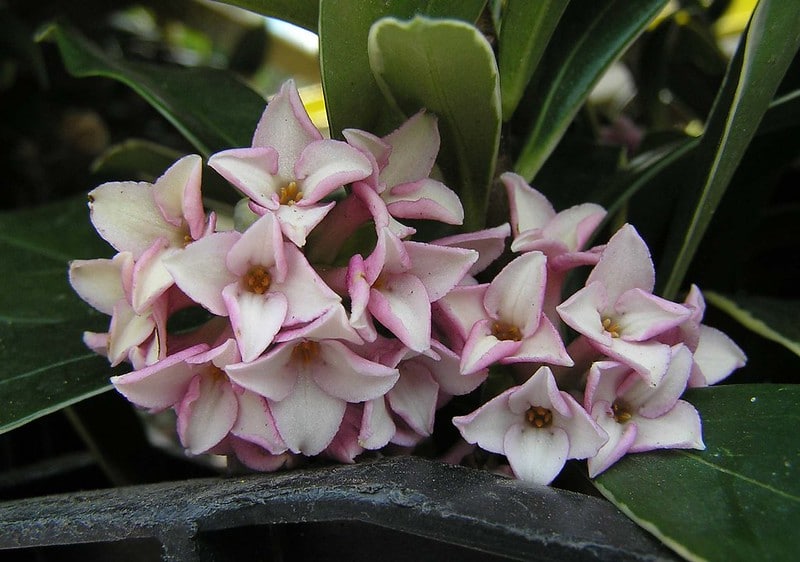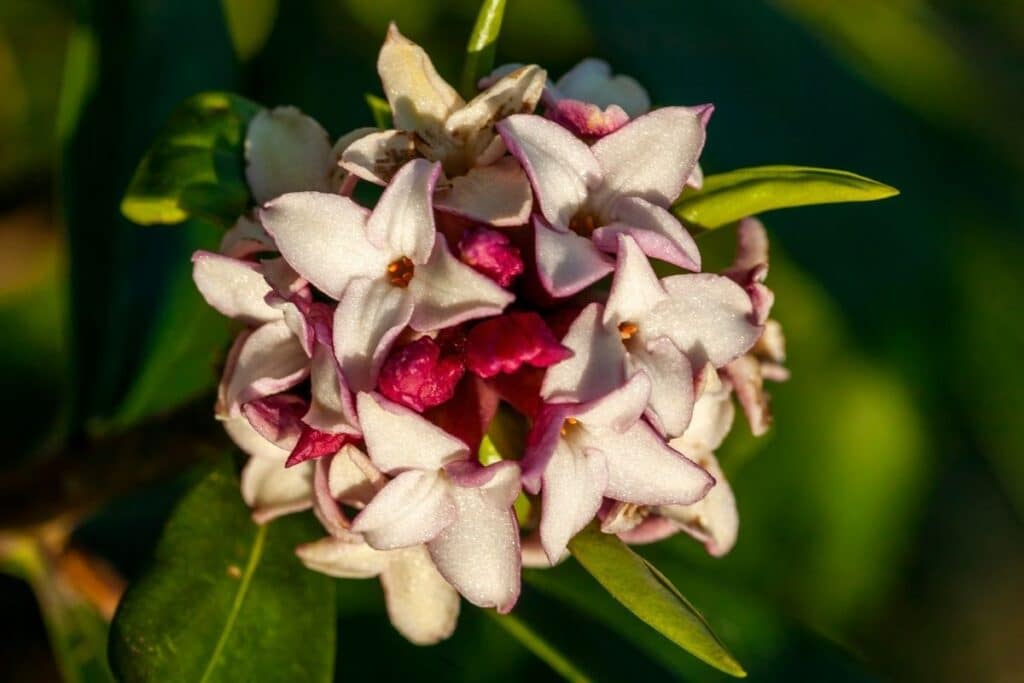Winter daphne is a showy and sweet-scented winter flowering shrub. As attractive as these plants are, it’s really their fragrance that makes growing them worth a little extra effort and planning.
They are known to be tricky to grow, short-lived, and more expensive than other plants, but armed with the right knowledge, you can successfully grow this wonderful plant in your garden.
What Is A Winter Daphne Shrub?
Winter daphne (Daphne odora), also known as the fragrant daphne, is a showy and broadleaf evergreen shrub of the family Thymelaeaceae. This plant often lives for just 3 or 4 years but if well taken care of, may live for a decade. All parts of this plant are known to be highly toxic.
These plants grow to a height of around 6 ft (1.8 m) tall, and a little wider, but often mature at about 4 ft (1.2 m) tall and grow in a naturally neat and rounded shape. They are native to China where they have a long history and have been cultivated for over a thousand years. (1)
These plants have variegated foliage, consisting of glossy and leathery green leaves that grow to about 3 or 4 inches (7.5 to 10 cm) long. In the popular variety ‘Aureomarginata,’ the leaves are variegated, being dark green with yellow margins.

Winter Daphne Flowers
These sweetly fragrant flowers are wonderfully fragrant and can be smelled from a great distance away. Plants begin to flower after 2 to 3 years of growth and will blossom quite profusely.
Individual flowers are purple, pink, or white and occur in clusters of about 2 inches (5 cm) across. Each flower measures about an inch across and usually has a white center, becoming pink towards the edges of the petals.
These tubular flowers have 4 lobes and flower in mid to late winter, a time when very few plants bloom. Although they are quite rarely produced, poisonous red fruits do occur.
How To Grow A Winter Daphne
Winter daphne shrubs can be grown from seeds removed from fruits. These seeds can be planted without cleaning and should germinate in the early spring months. Seeds that don’t germinate in their first spring can be left for the following spring to germinate.
These plants can also be grown from small greenwood or semi-ripe cuttings of 2 to 4 inches (5 to 10 cm) long. These cuttings will benefit from the use of a root hormone powder and will root after a period of 6 to 10 weeks if planted in a well-drained medium.
Winter daphne plants are sensitive and should not be transplanted once established as many plants will not survive this upheaval. These variegated winter daphne plants should be watered well, but be allowed to dry out somewhat between watering.
This winter daphne plant requires well drained soil that is rich in organic material. The roots of these plants mustn’t be kept in a saturated substrate, as wet soil can lead to issues like root rot.
You should plant winter daphne in a site with full sun to partial or dappled shade, sheltered from strong, persistent winds. A planting site that receives some afternoon shade is advised for gardens in very hot areas.
USDA hardiness zones 7 to 9 offer the right climate and temperatures for growing winter daphne and these plants will grow at a moderate rate there.
Care and Maintenance
Winter daphne is quite a sensitive plant, but it can withstand some light trimming. Care should be taken when pruning and plants should be monitored for signs of die-back after trimming. If affected, any affected branches should be removed and treated for fungal infection.
Due to their sensitivity and naturally neat and rounded shape, these plants are probably best left unpruned and growers should be mindful of the toxic sap produced that may irritate the skin if touched. (2)
Although not strictly necessary, the application of a slow-release fertilizer after blooming will help to invigorate these plants, resulting in brighter foliage. A light application of mulch around the roots of this plant is also recommended to keep the potting soil around the roots cool, just take care to leave the plants crown clear of mulch.
These plants are fairly pest and disease resistant if grown in the right conditions but are naturally short-lived, even when grown well. These plants may be susceptible to conditions such as root and crown rot, canker, fungal leaf spot, and botrytis. Pests such as mealybugs, aphids, and scale may potentially also affect these plants.
Uses
Horticultural Uses
Although daphne odora plant is a wonderful shrub for borders or foundation plantings, it is most often grown as a fine specimen plant, positioned where people can most enjoy its beauty and fragrance.
Wildlife Uses
The fragrant flowers of these plants attract bees, butterflies, and other pollinators in the winter when little else is available for them to feed on.
FAQs
Do daphne like being in pots?
Daphne plants can be grown in pots, but they typically prefer being planted in the ground where they have more space for root development and better access to nutrients and moisture
Why are my winter Daphne leaves turning yellow?
Yellowing leaves on winter Daphne plants can be caused by various factors, including overwatering, underwatering, nutrient deficiencies, poor drainage, or environmental stress. It’s essential to evaluate the plant’s care routine and growing conditions to identify and address the underlying cause of leaf yellowing.
What is the lifespan of a daphne plant?
The lifespan of a Daphne plant can vary depending on growing conditions, species, and care provided. In optimal conditions, Daphne plants can live for several decades, with some species reaching up to 20-30 years or more. However, factors such as disease, pests, and environmental stressors can impact their longevity.
Conclusion
Winter daphne is one of those plants that although sometimes difficult to keep, is still very rewarding for the more experienced gardener. Make sure to grow winter daphne plants in a well-drained area and resist the urge to prune them to enjoy their beauty and fragrance.
If you love shrubs and bushes, check this page for more!
References
Reference List:
(1) Gerald Klingaman. Plant Of The Week: Daphne, Winter. Retrieved at https://www.uaex.edu/yard-garden/resource-library/plant-week/daphne-winter-6-4-14.aspx
(2) Brickell, C. & Joyce, D. Pruning & Training, What, When & How To Prune.
Close
*image by winter daphne/depositphotos







